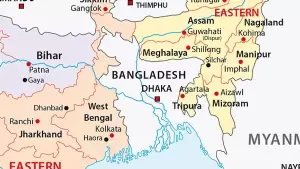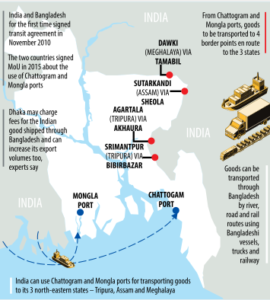Q. As India re-imagines its neighborhood, cross-border connectivity through sub-regions is becoming increasingly vital. Analyze.
Approach:
- Start by introducing about recent developments in a step towards sub-regional connectivity.
- Highlight the various steps taken in sub-regional connectivity along with India’s approach.
- Elaborate on the importance of sub-regional connectivity for India in its neighborhood.
- Briefly highlight the associated challenges and give a suitable way forward.
Answer:
India and Bangladesh made a joint decision to explore sub-regional connectivity initiatives with additional road and railway connectivity links to Nepal and rail links to Bhutan via Indian Territory. The idea of re-integrating India’s neighborhood through a sub-regional approach began to emerge in the late 1990s, but it was only in the mid-2000s that a sustained push for sub-regional connectivity started to take concrete shape.
Various steps taken in sub-regional connectivity
- BBIN (Bangladesh, Bhutan, India and Nepal) sub-regional Motor Vehicle Agreement (MVA). In 2015 bringing together the Bay of Bengal and the Himalayan sub-regions.
- The India-Myanmar-Thailand Trilateral Highway project and the sea-river-land Kaladan Multi-Modal Transit Transport Project aim to develop transport infrastructure in western Myanmar and North-eastern India form the key connectivity projects in linking India with the Mekong sub-region.
- The Chabahar agreement between Afghanistan, India, and Iran aims to fulfill the idea of building a sub-region around the Arabian Sea.
Importance of sub-regional connectivity for India in its neighborhood
- To boost trade & commerce: Transport corridors are the arteries through which trade, commerce, and people flow within and across countries. They become platforms for reducing poverty, generating employment, and promoting sustainable development by creating new economic opportunities for the countries being connected.
For example- seamless transport connectivity between India and Bangladesh has the potential to increase the national income of Bangladesh by 17 percent and 8 percent in India.
- Geostrategic response to China: China has massively expanded its diplomatic, economic, and political footprint across South Asia. To cater this, India needs to take the advantage of its geographical location to rethink its strategy because the default outcome of what the BRI is likely to accomplish in India’s periphery is its steady economic integration with China.
- Countering terrorism and extremism: Improved sub-regional connectivity can also help counter terrorism and extremism by promoting greater understanding and cooperation between neighboring countries and by reducing the opportunities for extremist groups to operate across borders.
- Better diplomatic relations in the region: Better connectivity in India’s sub-regions will support the idea of broader integration between South Asia, Southeast Asia, West Asia, Central Asia, eastern Africa, and the Indian Ocean where India can take the leading role.
- Foster Cultural exchange: Sub-regional connectivity will increase India’s engagement with other countries in its neighborhood and help in the development of the region based on the principles of cultural thinking and civilizational ethos.
Way Forward
- However, India’s sub-regional approach towards its neighborhood faces several challenges such as political instability as well as economic imbalances between countries in the region.
- Further, border disputes between India and some of its neighboring countries can also pose a challenge to sub-regional initiatives, as they can create tensions and disrupt trade and investment flows.
- Thus, an Indian connectivity strategy will have to consider the political, economic, and cultural sensitivities of the neighboring countries. At the same time, re-integrating the subcontinent by re-discovering the old as well as building new land, sea, and riverine corridors should be a key focus.
- Moreover, India should invest relatively more in the soft dimensions of connectivity, including capacity building.





